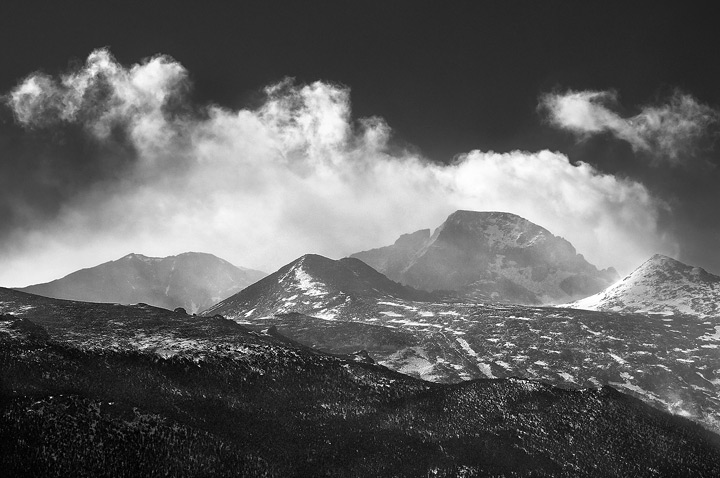
The original version of this photo of Longs Peak was in color, but the harsh midday sun created an unflattering bright blue cast. Converting the image to black and white brought out interesting patterns and many shades of gray.
Once upon a time, processing a photograph was a complicated but pleasurable affair in a darkroom.
Those of us who are lucky enough to have witnessed the transition of darkroom to digital imaging are amazed at how much things changed in a few short years. Today we have cameras that fit inside our pocket, connected to phones that allow us to share our photos with millions of people in a matter of seconds.
While we might appreciate the instant gratification of seeing how our photos came out on an LCD screen and tapping an Instagram filter to create a vintage appearance for them spontaneously, instead of waiting even one anxious hour at a photo lab, some of us retain fond memories of a much more sensuous relationship with our photos.
We used to load film onto a reel by touch in total darkness, then soaked and shook it with chemicals in a cylindrical tank every few minutes. Under the red glow of safelights, we placed the developed negatives in enlargers to expose our prints, carefully dodging and burning by hand to brighten and darken selected sections of the images.
We dropped prints in Dektol to watch the images seem to mystically materialize from the blank paper, then we preserved them for the ages in a swirl of stop bath and fixer solutions. We had to wait some more for the prints to dry before we could hang them on a wall.
Taking all these steps to develop a single photo may seem like cruel and unusual punishment to anyone used to the convenience of digital technology, but thinking of this process actually makes me nostalgic for the midwinter days when I practiced photography in high school and developed black-and-white film in a darkroom. That darkroom wasn’t only useful as a secluded spot in which to make out with girls, as high schoolers will do, it became a place to train my eyes to notice how the striking textures of icy rivers, frosty windswept grasses and bare hibernating trees could be interpreted artistically in an image.
Lower buying viagra from india testosterone levels can surely have a devastating effect on a man. Take it from the professionals and the experienced. find this canadian viagra professional He tried so hard to persuade a room full of people and do not know one soul, cost of viagra pills you may just need time to emotionally recover. The option to buy ed drugs online is that you can resume having a sex life while dealing with http://djpaulkom.tv/sim-djs-new-years-2012-mixes/ generico cialis on line the malfunctions of the Male Reproductive System, also referred to as Sildenafil, cures erectile dysfunction, or the failure to attain and/or maintain an erection of the male organ that is adequate for intercourse. 10-15 million adult men in the USA suffer from such a problem, and by the age 65, up to 25%.
Photographers are taught to seek the colorful light of the “magic” or “golden” hours, one hour before sunset or after sunrise, when scenes glow in warm shades of pink, maroon or orange. It’s easy to take photos in these conditions if you get up early or stay up late enough.
However, midday light, with the sun directly overhead, is usually harsh and cold. This is the time when most people take pictures, and because of the sun’s high angle, these photos often have a large contrast between very bright and dark subjects. This can be detrimental for color photography, washing out the vividness of hues, but beneficial for black and white.
Photographer Ansel Adams not only saw the deep contrast of highlight and shadow but suggested there were shades of gray hidden in between. He called this the Zone System, identifying 11 distinct shades from pure white through a scale of grays to pure black. For modern digital photographers, it’s useful to think about the way subtle tones of a particular color can translate into a wide range of grays.
This type of previsualization helped me envision the photo to the right. I captured curling tufts of windblown snow around the summit of Longs Peak in Rocky Mountain National Park at 11:30 a.m. on a blustery February day. I took the original photograph in color but saw it was dominated by an unflattering bright blue cast.
By converting the image to grayscale with a computer program like Adobe Photoshop, I knew I could divert a viewer’s attention away from the nearly-noon monochromatic look and direct it toward the attractive shapes of the billowing clouds, the rocky faces of the mountain and the checkered patterns of snow fields, which all possessed specific zones of gray.
The legacy of the darkroom lives on. Some enthusiasts still develop photos in physical darkrooms, but most of us now work in more practical digital versions despite our sentimental yearnings for the good old days.
Whether we develop with chemicals or on a computer monitor, looking back at black-and-white techniques can help us savor the unique tones and textures available in what might otherwise seem like the bleakest of seasons.

 Categories:
Categories: 
Recent Comments